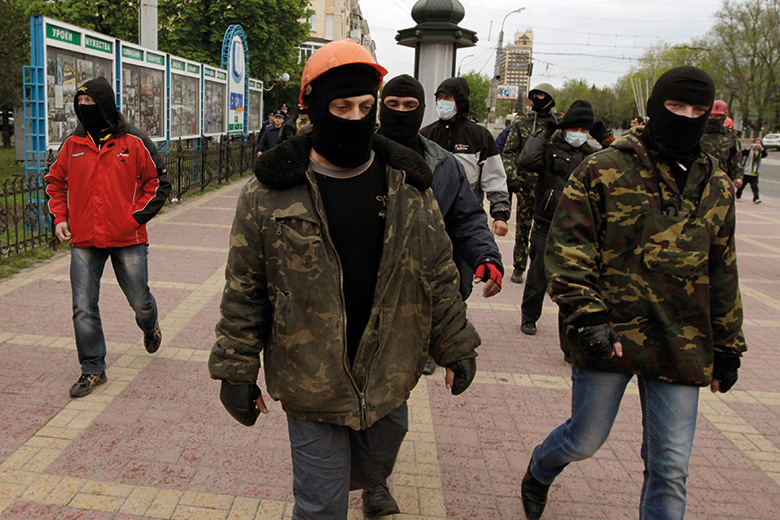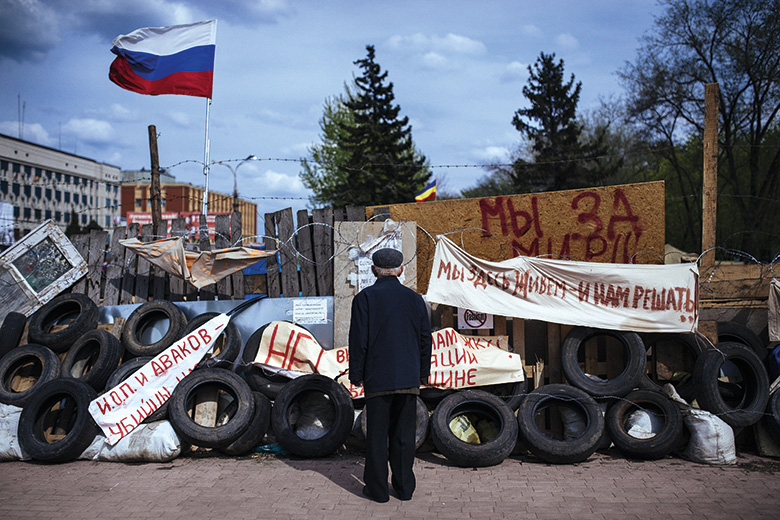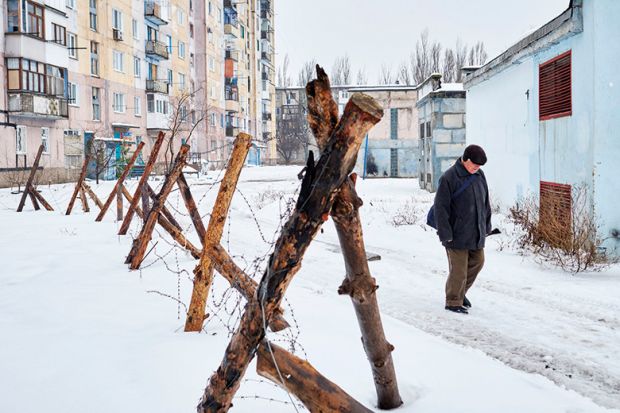"Our university was the largest educational institution in the east of Ukraine, and the oldest,” says Serhii Savchenko. “Before these events, the situation in Luhansk was quite normal, and our university had a healthy environment for studying and research.”
Savchenko began working at Luhansk Taras Shevchenko National University 23 years ago, and, by the time Russia’s annexations of the Crimean peninsula and the city of Sevastopol shook Ukraine in March 2014, he had become first vice-rector of the institution.
When, the following month, fighting broke out in eastern Ukraine between the Ukrainian army and pro-Russian separatist rebels, the university – commonly referred to as the University of Luhansk, or LNU – found itself in a difficult situation. Many university staff and students had been involved with the pro-Ukrainian, pro-European Union demonstrations that had resulted in the removal of the democratically elected pro-Russian president Viktor Yanukovych in February 2014.
“Our lecturers and students tried to put across a message for Ukraine; we wanted to protect our values, the way we understand Ukraine as our homeland and country,” Savchenko tells Times Higher Education.
The rebels soon entered the city of Luhansk and captured the headquarters of the Security Service of Ukraine, just a couple of hundred metres from the LNU campus. Luckily, most of the university’s students had left for their summer break by the time the gunmen arrived at its doors, but many international students remained. When the soldiers entered the dormitories, Savchenko and his colleagues immediately set about evacuating them, hiring cars to take them to the airport.
“[The rebels] came a lot of times to my office with guns, with Kalashnikovs, and they told me that I need to give them equipment and resources and so on,” Savchenko says. “They took mattresses from dormitories, and they demanded that we allow…Russian army personnel to live at the dormitories. And I didn’t [want to] allow this, but they did it by force.”
As the rebels cemented their position in Luhansk province, they renamed the region the Luhansk People’s Republic, and a plan (since aborted) was quickly hatched to unite it with the neighbouring rebel-christened Donetsk People’s Republic under the name Novorossiya: “New Russia”. LNU’s administrators were frequently threatened, and it became painfully clear to them that they were now living in a war zone; Savchenko reports that university buildings were damaged 10 times during shelling in the summer of 2014. The administrators remained, to protect university resources from being stolen, but the future looked bleak.
“We saw that there wouldn’t be any quick and easy solution [to the fighting],” says Dmytro Uzhchenko, who, as vice-rector for academic affairs and research at LNU, had sought to collaborate more closely with European organisations. “And we knew that under those circumstances we couldn’t open our doors to the students.”
The administrators’ hand was forced at the start of autumn, when the rebels decided that the presence of university staff could be tolerated no longer. Savchenko himself was arrested in his home, which was searched three times.
“I and three other directors managed to escape, having taken with us only what we could wear,” he says. “My suit was all I had the day that I left.”
But Uzhchenko, who was arrested in his office, did not share his colleague’s luck.
“For 26 days I was…I don’t know where I was. I know it was a basement. After I was released, I left for Ukraine-controlled territory,” he says. “Those in power just wanted to get rid of the university administration.”

Uzhchenko joined Savchenko and the other university administrators 100km away in Starobilsk, a small city in Luhansk province that has remained under Ukrainian control throughout the war. There was in Starobilsk a satellite branch of LNU, which, for a decade, had been home to a single detached faculty. The administrators decided to use it as the base for a new, semi-virtual version of the university.
As the new academic year dawned, university officials used social media to announce the evacuation of the Luhansk campus to students and staff and to call them to Starobilsk instead. Most heeded the call – although about 20 per cent of staff remained in Luhansk to form an illegal offshoot of the university controlled by the rebels.
Having fled so suddenly, the university administrators found themselves having to develop from scratch entirely new teaching materials, as well as a library.
“We didn’t have anything in place because [before we left] we were just waiting for Luhansk to be liberated by the Ukrainian army,” says Uzhchenko. “The teachers came with what they had in their hands; maybe some textbooks or maybe a laptop – but that was all.”
In the immediate aftermath of the evacuation, the exiled university received some foreign and domestic aid, including donated hygiene products and clothing, and the reconvened staff worked every day of the week to get it up and running.
Another big problem was that the Starobilsk site had only enough space to accommodate 500 students. Hence, Savchenko and his team quickly developed distance and blended learning programmes so that even students in rebel-controlled territory could continue studying. The university is currently testing a new educational platform, e-university, that could allow distant students to listen to lectures on their phones.
“It’s only those circumstances [that] pushed us towards this form of education,” says Uzhchenko. “[But] we understand that when we return to Luhansk and our campus, all that we are working on now will only be developing [further]. So we will still use blended learning because we see its potential: it’s more convenient, more effective. It allows academic mobility as well: it could be used, for example, during a term or an internship in a different country.”
LNU now has 8,000 students – including 3,000 first-year students and 100 international ones – and is functioning in four different cities in Ukraine, having relocated its faculties of physical education, foreign languages and culture and arts. And it is forming new partnerships with international organisations, including the British Council, whose support includes a leadership capacity-building programme.
“The partnership with the British Council is very important for us because it is showing moral support for us,” says Savchenko. “The most important thing is that it is showing our students that we are in the unified European higher education space: that they recognise us and we are in the same European family.”

In total, 16 Ukrainian universities – classical and technical, private and public, general and specialised – have been forced to evacuate because of the war in the east. Another example is Donetsk National University, which moved into a former jewellery factory in the city of Vinnytsia after its dormitories were captured and used as barracks by rebel gunmen.
The Ukrainian government established a centre to support internally displaced students, and the Ministry of Education and Science has been working with universities to address legal and administrative issues. Last November, the Ukrainian parliament passed a law to support the exiled universities by cementing their status, easing certain regulations and committing the government to helping restore their facilities once the “anti-terrorist operation” is over.
Those institutions have all experienced threats, violence and disruption, but they share a conviction that they are making a virtue out of a necessity by switching to e-learning. Volodymyr Dahl East Ukrainian National University (EUNU), which, before the war, had 1,500 academic staff and 20,000 students, was evacuated from Luhansk to the city of Sievierodonetsk in September 2014. Staff and students became scattered across Ukraine, and the university initially could not provide salaries, accommodation or resources for teaching or research. When its council first met in Sievierodonetsk, they “revised [their] strategy altogether”, according to the institution’s rector, Olga Porkuian, who is also chair of the Rectors Council of the Displaced Universities of Luhansk. Its adoption of electronic and distance learning has enabled it, despite everything, to expand its student numbers.
“I think when we come back [to our home campus], it will be different,” says Porkuian. “We don’t want to go back to the old [way of doing things]: we want to move forward.”
One of the university’s new e-students is Renata Mekhrabova, who chose to study translation at EUNU when it opened a new philology department after its exile.
“We do the homework and individual assignments and send them to our lecturers and tutors, who are sometimes in other parts of Ukraine,” she says.
The war has “changed [her] lens on the future”, and, after she graduates, she now wants to teach English at the university. “I want our university to go back and reach the same level it was [at] before the [war], and even [higher]. I want to make my own effort to contribute to our university’s prosperity and development,” she explains.
While the war in eastern Ukraine continues, it is unlikely that any of the exiled universities will return to the campuses they left behind. For its part, LNU could be facing 10 years or more of exile, Savchenko says, and it is unclear what will be left of its home campus when the soldiers finally relinquish it.
“The buildings are still there,” notes Uzhchenko. “[But] we don’t know what’s inside: probably nothing. We are not in contact with those who captured our university. What they stole, what they left: we don’t know.”
Nevertheless, Savchenko remains optimistic, noting that LNU was also displaced twice during the Second World War.
“We always got out of that situation as winners, and we will be winners in this situation as well,” he predicts.




